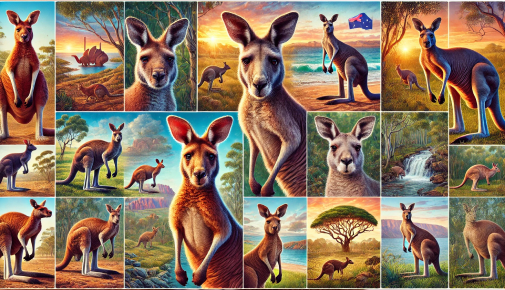Australia is home to a wide variety of kangaroo species, each with its own unique traits, behaviors, and ecological significance. These iconic marsupials are more than just symbols of the Australian wilderness—they play vital roles in their ecosystems. In this article, we will explore the different kangaroo species found across the country, their habitats, and the characteristics that make them so special.
1. What Are Kangaroo Species?
Kangaroo species belong to the family Macropodidae, which translates to “big foot.” These marsupials are large, known for their powerful hind legs, strong tails, and distinctive hopping gait. Additionally, kangaroo species are herbivores, primarily feeding on grasses, leaves, and shrubs. This diet, combined with their ability to travel long distances in search of food and water, allows them to thrive in the harsh environments of Australia.
2. Types of Kangaroo Species
Australia is home to several kangaroo species, each suited to a specific environment. Below are some of the key kangaroo species found in the country:
Red Kangaroo Species (Macropus rufus)
The red kangaroo is the largest and most recognized of the kangaroo species. Males can grow up to 8 feet in length, including their tail, and weigh over 200 pounds. They primarily inhabit the arid regions of Australia, where their unique adaptations allow them to survive in extreme conditions. Red kangaroo species are characterized by their reddish-brown fur and long, muscular tails, which they use for balance while hopping.
Eastern Grey Kangaroo Species (Macropus giganteus)
In contrast, the Eastern grey kangaroo is the second-largest of the kangaroo species and is commonly found in the eastern and southeastern parts of Australia. Unlike the red kangaroo, Eastern greys have a more muted gray coat. These kangaroo species thrive in open woodlands, grasslands, and even suburban areas, where they can often be seen in smaller mobs.
Antilopine Kangaroo Species (Macropus antilopinus)
Another fascinating kangaroo species is the antilopine kangaroo, native to northern Australia. Known for its resemblance to antelopes, the antilopine kangaroo has long, slim legs and a lighter coat. This species typically inhabits tropical savannas and is more elusive, often found in remote, forested areas.
Western Grey Kangaroo Species (Macropus fuliginosus)
Meanwhile, the Western grey kangaroo, found in southern and western regions of Australia, is smaller than both the red and Eastern grey kangaroo species. With a mix of gray and brown fur, Western grey kangaroo species are often seen in open woodlands and grasslands, where they form larger groups.
Wallaroo Species (Genus: Osphranter)
In addition to the common kangaroo species, Australia is also home to wallaroos. These stockier, smaller kangaroos are found in rocky, hilly terrains. The common wallaroo, black wallaroo, and euro wallaroo are all unique kangaroo species that navigate rough landscapes and thrive in remote, rugged areas.
3. Kangaroo Species’ Habitat and Behavior
Kangaroo species are incredibly adaptable animals, capable of thriving in diverse habitats, from dry deserts to lush forests and coastal regions. Their ability to travel large distances in search of food and water enables kangaroo species to survive in conditions that would challenge many other species. Furthermore, these animals are social and often form groups, known as mobs. The size of these mobs varies depending on food availability and environmental conditions.
Kangaroo species are typically most active in the early morning and late afternoon, foraging for food. During the hotter parts of the day, they rest in the shade to avoid dehydration.
4. Conservation Status of Kangaroo Species
Although many kangaroo species remain stable in number, they face threats such as habitat destruction, climate change, and hunting. In response, the Australian government has set strict quotas for hunting to ensure sustainable populations. Nevertheless, ongoing conservation efforts are essential to protect these animals for future generations.
Some kangaroo species, such as the Eastern grey kangaroo, are considered “least concern” by the International Union for Conservation of Nature (IUCN). However, other species, like the Antilopine kangaroo, are more vulnerable due to their specialized habitat needs.
5. Interesting Facts About Kangaroo Species
There are several remarkable facts about kangaroo species:
- Hopping Adaptation: The unique hopping gait of kangaroo species allows them to cover long distances with minimal energy. Their powerful hind legs and tails are crucial for this mode of travel.
- Kangaroo Pouches: Female kangaroo species carry their young in pouches, offering them warmth, protection, and easy access to milk during early development stages.
- Communication: Kangaroo species communicate using various sounds and body language. Thumping their feet is a common warning behavior to alert others of danger.
6. Why Kangaroo Species Are Iconic to Australia
Kangaroo species are more than just remarkable animals—they are an emblem of Australia itself. Featured on the Australian coat of arms, coins, and numerous pieces of art, kangaroos represent the country’s resilience and natural beauty. They also hold cultural significance for Indigenous Australians, appearing in traditional stories, artwork, and ceremonies.
Conclusion
In conclusion, kangaroo species are diverse and fascinating marsupials that embody the spirit of Australia. From the towering red kangaroo to the smaller wallaroos, these species have adapted to a wide range of environments, each playing an essential role in their respective ecosystems. Understanding the different kangaroo species and their behaviors provides a deeper appreciation for these iconic animals and underscores the importance of protecting them for future generations.


